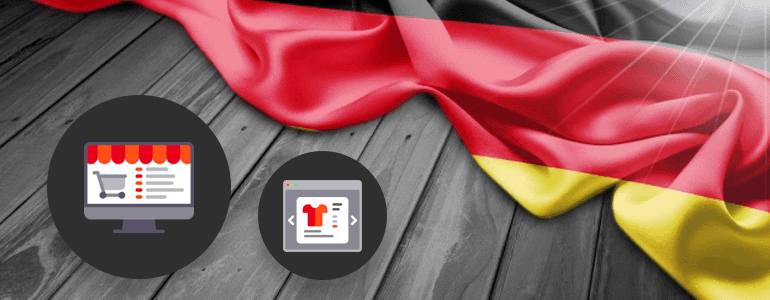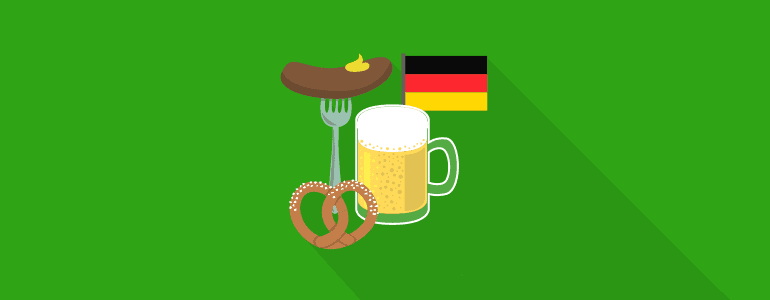
[FREE report] Ecommerce in Germany: the definitive guide
Germany is one of the top markets in Europe and leaders for cross-border trade. Its total purchasing power presents big opportunities for online store owners.
Interested in more ecommerce facts, figures and trends for the German ecommerce market? Read more and check out our comprehensive report!
Germany: attractive ecommerce country

In the world of business, Germans are their own brand. The Made in Germany quality of products and services speaks for itself. The German brand matters around the world.
Germany is also a large ecommerce market. It’s well-populated with buyers who are smart, savvy and well acquainted with online shopping.
It’s a mature marketplace, showing slowing growth, yet its size, infrastructure and advanced state of ecommerce are still attracting global sellers.
German marketplace: general characteristics
Germany is a heavily populated country with a high Internet penetration rate and millions of consumers making online purchases on a regular basis.
It belongs to the top markets in Europe when it comes to population, internet use and total purchasing power. German is spoken by 95% of the local population.
German ecommerce in numbers
- Population: 80.69 million
- Active internet users: 71.73 million
- Active social media users: 29 million
- Active mobile social media users: 24 million
- Population shopping online: 87%
- Average spending per eshopper: € 1 585
- Digital commerce growth: 16%
![[FREE report] Ecommerce in Germany: the definitive guide digital commerce growth germany](data:image/svg+xml,%3Csvg%20xmlns='http://www.w3.org/2000/svg'%20viewBox='0%200%20619%20412'%3E%3C/svg%3E) Online buyer behaviour
Online buyer behaviour
A typical German shopper is between 30 and 40 years old, living in an urban area of the country. There are differences between German shoppers from Western Germany and shoppers from the East, which has to do with World War II.
Furthermore, dealing with German online shoppers, international ecommerce sellers should definitely take into account cultural differences.
![[FREE report] Ecommerce in Germany: the definitive guide expert advice ecommerce germany](https://www.webinterpret.com/wp-content/uploads/2017/09/expert-advice-ecommerce-germany.png)
Since trusted, recognised, local retailers are favoured, international sellers should aim for a localized website, with the .de domain if possible.
Additionally, a legal statement confirming the owner of the site, a.k.a. Impressum, should be included on websites. Quality seals of approval, certificates, badges and symbols are also likely to bring German shoppers closer to your brand.
Finally, according to German law, consumers can return their purchases within 14 days with no need for explanation. This results in higher return rates.
Popular product categories
Among top products purchased by German online buyers are clothing/footwear, books, home electronics, CDs and films/DVDs.
![[FREE report] Ecommerce in Germany: the definitive guide top products bought online germany](data:image/svg+xml,%3Csvg%20xmlns='http://www.w3.org/2000/svg'%20viewBox='0%200%20619%20359'%3E%3C/svg%3E) Logistics, delivery & shipping
Logistics, delivery & shipping
The German infrastructure is well-developed with a concentrated network of logistic centres. In Germany, there is a privatized national mail service (Deutsche Post). Its subsidiary, DHL, plays a significant role in the European shipping landscape. Other strong market players in Germany include myHermes (Otto Group) and DPD.
The most popular delivery method in Germany is home delivery, preferred by 87% of the population. However, German buyers are becoming more and more open to delivery alternatives, such as click & collect and delivery to pickup-up points, e.g. parcel lockers, which saves the buyer from paying a premium for rush orders.
International online sellers should remember that Germany has one of the most precise customs procedures in the world. Hence, if the parcel is held for further investigation the result will be extra delays.
Advice from our shipping expert
Yo can reduce shipping prices by offering a delivery to pick-up points. It’s a good way to remove the premium cost paid in the case of home delivery.
Additionally, to prevent the impact of high return rates on your business, Adrien stresses the importance of understanding the reasons for returns. This way, you’ll be able to efficiently manage your product catalogue available to German buyers.
Payment methods preferred by ecommerce buyers in Germany
![[FREE report] Ecommerce in Germany: the definitive guide ecommerce payment 300x300](https://www.webinterpret.com/wp-content/uploads/2017/07/ecommerce-payment--300x300.png)
However, here’s a word of caution…
Even though many German buyers pay by credit card, assuming that everybody will be happy to do so can result in poor checkout conversion rates.
The truth is that some risk-averse Germans want to avoid credit cards or debt in any shape or form. Additionally, compared to British online shoppers, Germans feel less trustful and less confident about entering payment card details.
It’s important to reassure the German buyer that they’re dealing with a secure payment system
When ordering products online, it’s quite typical of German consumers to pay afterwards. Thus, paying by invoice, as opposed to paying upfront, is quite common.
Mobile commerce in Germany
The mobile share of retail ecommerce sales in Germany amounts to 38%. Even though Germany is a bit behind the UK (52%), which ranked first, it’s still one of the mcommerce leaders in Europe.
Germany hasn’t experienced a rapid growth in mobile usage for ecommerce purposes. However, mobile commerce is growing steadily and seems to be finally catching up. Smartphones are much more popular than tablets among mobile shoppers in Germany.
Cross-border shopping
53% of German internet users purchased a product from abroad in 2015, which is a good result compared to other European countries. Further, Germany is responsible for 15% of global cross-border sales.
Favourite online shopping destinations of German online shoppers include the UK, the USA and China.
![[FREE report] Ecommerce in Germany: the definitive guide top countries germans buy from](data:image/svg+xml,%3Csvg%20xmlns='http://www.w3.org/2000/svg'%20viewBox='0%200%20500%20401'%3E%3C/svg%3E) Benefits of selling your products online in Germany
Benefits of selling your products online in Germany
Germany is strategically located in the heart of Europe and belongs to the strongest economies in the world. Being a well-populated country with high purchasing and spending power as well as a well-established, logistics-friendly infrastructure, it presents opportunities for international ecommerce sellers.
The maturity of the German ecommerce market means more competition, but also more predictability as well as popularity of online shopping.
It’s also worth noting that Germany is one of the leading European markets for cross-border trade. In other words, Germans are keen on shopping from international websites. This means that setting up and localizing your online store on the German marketplace may bring you a lot of extra revenue.
Finally, having established your online presence in Germany, you can also consider other German-speaking ecommerce markets, e.g. Austria and Switzerland. Due to linguistic similarities and geographical proximity, many Austrian and Swiss shoppers are eager to buy from Germany.
Challenges for German ecommerce
First, online sellers planning an expansion to Germany should consider the maturity of that market and a large number of competing businesses. For some online store owners it may be better to test emerging markets, e.g. India or China, whose strength lies in large populations/purchasing power.
Second, high return rates may be a bit of a nuisance for retailers. Return rates range from 5-10% for electronics to 70% for fashion in online sales. This is motivated by the consumer protection laid out by the local legislation and high consumer expectations. Thus, a good solution may be a local return address.
Third, since German is spoken by 95% of the local population, some sellers can see the language barrier as an obstacle.
Luckily, there’s a good solution for international online sellers:
Offering a localized buying experience.
Offering a localized buying experience includes using the buyer’s language, payment methods but also displaying prices in the local currency and accounting for many other aspects of ecommerce localization.
There are affordable ecommerce solutions that do exactly that, which saves retailers a lot of time and hassle.
In a nutshell
Germany belongs to the top ecommerce markets in Europe and as such should be considered by growth-minded international online merchants.
The market may have its challenges, such as maturity, high return rates and demanding consumers, yet its total purchasing power presents big opportunities for online store owners.
Winning the trust of German buyers may take some time, but your efforts may result in customers that will be keen shoppers, loyal to your brand for a long time to come.
So do some research and once you’ve identified opportunities for your online store on the German marketplace, win the local buyer with a localized buying experience!
To access the FULL report, click below to download it for FREE!
Sources
Lengow. German Ecommerce Outlook.
Ecommerce in the UK: the definitive guide
Demandware Shopping Index.
Online Retailing: Britain, Europe, US and Canada 2017
Germany B2C E-commerce Report 2016.
Twenga Solutions.
Landmark Global
2016 Digital Yearbook.
Ecommerce in Europe 2015.
Ecommerce News Europe.
Mobile share of retail e-commerce sales
Related Posts:
Ecommerce Newsletter
By clicking the “Subscribe now” button, you agree to receive our monthly e-mail newsletter and regular marketing and commercial communications by email from Webinterpret regarding marketing trends and our digital marketing services. You confirm that you have read and agreed to Webinterpret’s Terms of Service and Privacy Policy.
![[FREE report] Ecommerce in Germany: the definitive guide digital commerce growth germany](https://www.webinterpret.com/wp-content/uploads/2017/09/digital-commerce-growth-germany.png) Online buyer behaviour
Online buyer behaviour![[FREE report] Ecommerce in Germany: the definitive guide top products bought online germany](https://www.webinterpret.com/wp-content/uploads/2017/09/top-products-bought-online-germany.png) Logistics, delivery & shipping
Logistics, delivery & shipping![[FREE report] Ecommerce in Germany: the definitive guide expert advice shipping ecommerce germany](https://www.webinterpret.com/wp-content/uploads/2017/09/expert-advice-shipping-ecommerce-germany.png)
![[FREE report] Ecommerce in Germany: the definitive guide mobile share ecommerce sales germany](https://www.webinterpret.com/wp-content/uploads/2017/09/mobile-share-ecommerce-sales-germany.png)
![[FREE report] Ecommerce in Germany: the definitive guide top countries germans buy from](https://www.webinterpret.com/wp-content/uploads/2017/09/top-countries-germans-buy-from.png) Benefits of selling your products online in Germany
Benefits of selling your products online in Germany
![Amazon Advertising: all you need to know [FREE guide] Amazon Advertising: Ecommerce Guide](https://www.webinterpret.com/wp-content/uploads/2020/07/amazon-advertising-ecommerce-guide.png)
